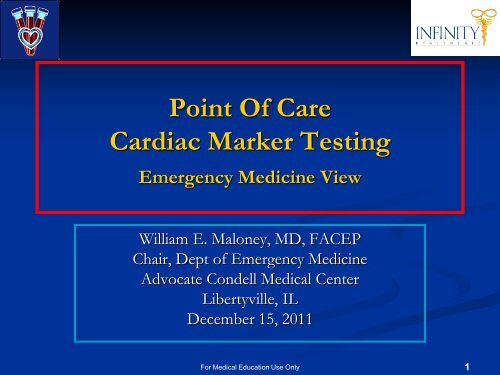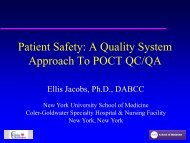Point Of Care Cardiac Marker Testing
Point Of Care Cardiac Marker Testing
Point Of Care Cardiac Marker Testing
You also want an ePaper? Increase the reach of your titles
YUMPU automatically turns print PDFs into web optimized ePapers that Google loves.
<strong>Point</strong> <strong>Of</strong> <strong>Care</strong><br />
<strong>Cardiac</strong> <strong>Marker</strong> <strong>Testing</strong><br />
Emergency Medicine View<br />
William E. Maloney, MD, FACEP<br />
Chair, Dept of Emergency Medicine<br />
Advocate Condell Medical Center<br />
Libertyville, IL<br />
December 15, 2011<br />
For Medical Education Use Only 1
Learning Objectives<br />
� Overview of ED cardiac marker POC testing<br />
� Some of the key studies<br />
� Recent ACC/AHA & ACEP guidelines<br />
� Strategies for success<br />
For Medical Education Use Only<br />
2
3<br />
Challenges in Chest Pain Triage<br />
Over admissions and Missed MIs<br />
US statistics<br />
Treat or discharge<br />
CCU/CPEC/Other<br />
Rx/PTCA/Other<br />
CCU
Issues in Diagnosis of NSTEMI<br />
1. NSTEMI is a time dependent disease<br />
2. Troponin values are the critical diagnostic test<br />
3. Troponin does not elevate until >6 hours post AMI onset<br />
CRITICAL CHALLENGE:<br />
Can earlier markers of necrosis predict<br />
subsequent elevations in troponin?<br />
For Medical Education Use Only<br />
4
80<br />
70<br />
60<br />
50<br />
40<br />
30<br />
20<br />
10<br />
0<br />
Appearance of<br />
Three <strong>Marker</strong>s of Myonecrosis<br />
0 2 4 6 8 12 18 24 32 48 72<br />
Hours After Onset of MI<br />
For Medical Education Use Only<br />
CKMB<br />
Myoglobin<br />
TnI<br />
5
The Value of <strong>Point</strong>-of-<strong>Care</strong><br />
<strong>Cardiac</strong> <strong>Marker</strong> <strong>Testing</strong><br />
Class I Recommendation:<br />
Institutions that cannot consistently<br />
deliver cardiac marker TAT’s of < 1<br />
hour should implement POC testing<br />
devices.<br />
Wu et al. Clinical Chemistry 1999;45:1104-1121.<br />
For Medical Education Use Only<br />
Session I, page 1105<br />
6
Ninety-Minute Exclusion of Acute Myocardial<br />
Infarction By Use of Quantitative <strong>Point</strong>-of-<strong>Care</strong><br />
<strong>Testing</strong> of Myoglobin and Troponin I<br />
J. McCord; RM Nowak; PA McCullough; C<br />
Foreback; S Borzak; G Tokarski; MC<br />
Tomlanovich; G Jacobsen; WD Weaver<br />
For Medical Education Use Only 7
Background & Methods<br />
� 817 consecutive chest pain patients presenting to urban ED<br />
� Blood markers drawn in those with nondiagnostic ECG<br />
� 65 patients (9%) were determined to have AMI<br />
� 27 patients (36% of AMI patients had normal TnI at presentation)<br />
� Patients presenting with AMI are often missed in the critical<br />
early hours.<br />
McCord et al: AJC, Vol. 94. pp 864-867: October, 2004<br />
For Medical Education Use Only<br />
8
90 minute AMI Exclusion Study<br />
� Hypothesis:<br />
� Multimarker strategy (MMS) can exclude MI in<br />
under 3 hours<br />
� Methods:<br />
� 817 consecutive patients presenting to ED for<br />
evaluation of possible ACS<br />
� <strong>Point</strong> of care measurement of myoglobin, TnI, and<br />
CK-MB done at presentation, 90 min, 3 and 9 hours<br />
� Standard laboratory CK-MB done at same time<br />
� Triage in ED done by physicians unaware of the<br />
point of care results<br />
McCord J et al. Circulation 2001;104:1483-88<br />
For Medical Education Use Only<br />
9
Myoglobin in Early Hours of AMI<br />
(Prior to Troponin Release)<br />
All Patients Confirmed AMI via Subsequent Troponin positivity<br />
600<br />
500<br />
400<br />
300<br />
200<br />
100<br />
0<br />
McCord et al: AJC, Vol. 94. pp 864-867: October, 2004:<br />
Table 2 Adapted<br />
Baseline 90 Min 120 Min<br />
Patient 1 Patient 2 Patient 3 Patient 4 Patient 5<br />
For Medical Education Use Only<br />
10
ng/ml<br />
400<br />
350<br />
300<br />
250<br />
200<br />
150<br />
100<br />
50<br />
0<br />
McCord et. al. Circulation 2001 ; 104:1483 - 1488<br />
Value of Myoglobin with<br />
Troponin Negative at Presentation<br />
AMI vs. Non-<strong>Cardiac</strong> Origin<br />
0 HR 90 MINS 3 HR<br />
For Medical Education Use Only<br />
AMI(- cTnI)<br />
Noncardiac<br />
11
Time<br />
(min)<br />
80<br />
70<br />
60<br />
50<br />
40<br />
30<br />
20<br />
10<br />
McCord J et al. Circulation 2001;104:1483-88<br />
0<br />
Henry Ford Trial: Time to<br />
Laboratory Reporting<br />
71<br />
Central Lab <strong>Point</strong> of <strong>Care</strong> Device<br />
For Medical Education Use Only<br />
24<br />
12
The combination of Myo and cTnI at 0 and 90<br />
mins had the highest early negative predictive<br />
value and sensitivity<br />
Sensitivity<br />
NPV 99.6% 99.5%<br />
The 3 hour blood sampling did not improve<br />
early sensitivity or negative predictive value<br />
McCord et. al. Circulation 2001 ; 104:1483 - 1488<br />
Results<br />
0, 90<br />
min<br />
96.9%<br />
For Medical Education Use Only<br />
0, 90 min, 3<br />
hrs<br />
96.9%<br />
13
2006 ACEP Guidelines<br />
re: <strong>Cardiac</strong> Biomarkers<br />
(Level B Recommendations)<br />
� “..single negative CK-MB mass, Troponin I, or<br />
Troponin T measured 8 to 12 hours after…onset”<br />
� “..negative myoglobin in conjunction with a<br />
negative CKMB mass, or negative Troponin when<br />
measured at baseline and 90 minutes in patients<br />
presenting less than 8 hours after symptom onset”<br />
� “..negative 2-hour delta CK-MB mass…with a<br />
negative 2-hour delta Troponin in patients<br />
presenting less than 8 hours after symptom onset”<br />
Fesmire FM et al. Ann Emerg Med 2006;48:270-301.<br />
For Medical Education Use Only<br />
14
2006 ACEP Guidelines<br />
re: <strong>Cardiac</strong> Biomarkers<br />
“No single serum marker used alone<br />
has sufficient sensitivity or specificity<br />
to reliably identify or exclude AMI<br />
within 6 hours after symptom<br />
onset.”<br />
Fesmire FM et al. Ann Emerg Med 2006;48:270-301<br />
For Medical Education Use Only<br />
15
2006 ACEP Guidelines<br />
Conclusions<br />
� Within the first 8 hours of symptoms:<br />
Multi-marker<br />
� After 8 hours: Single CK-MB or<br />
Troponin<br />
Fesmire FM et al. Ann Emerg Med 2006;48:270-301<br />
For Medical Education Use Only<br />
16
2007 ACC/AHA Guidelines<br />
(Regarding UA/Non-STEMI)<br />
� Class I - <strong>Cardiac</strong> biomarkers all patients<br />
� Troponin is preferred marker<br />
� “..exact timing of serum marker measurement should take<br />
into account the uncertainties often present with the exact<br />
timing of onset of pain and the sensitivity, precision, and<br />
institutional norms of the assay being utilized as well as<br />
the release kinetics of the marker being measured.”<br />
Anderson et al. ACC/AHA 2007 Guidelines. Circulation.<br />
2007: 16:3148-e304.<br />
For Medical Education Use Only<br />
17
2007 ACC/AHA Guidelines<br />
(Risk Stratification)<br />
� Class IIb ...”within 6 hours of onset…<br />
� an earlier marker (e.g., myoglobin) in conjunction<br />
with a late marker (e.g., troponin) ..<br />
� 2-h delta CK-MB mass in conjunction with 2-h<br />
delta troponin..<br />
� myoglobin in conjunction with CK-MB mass or<br />
troponin when measured at baseline and 90 min”<br />
Anderson et al. ACC/AHA 2007 Guidelines. Circulation.<br />
2007: 16:3148-e304.<br />
For Medical Education Use Only<br />
18
2007 ACC/AHA Guidelines<br />
(Risk Stratification)<br />
� Class IIb - “Measurement of B-type natriuretic<br />
peptide (BNP) or NT-pro-BNP may be considered<br />
to supplement assessment of global risk in patients<br />
with suspected ACS”<br />
� An isolated, early elevation [of myoglobin] in<br />
patients with non-dx ECG should not be relied on<br />
to make the diagnosis of MI<br />
Anderson et al. ACC/AHA 2007 Guidelines. Circulation.<br />
2007: 16:3148-e304.<br />
For Medical Education Use Only<br />
19
A rapid point-of-care cardiac marker<br />
testing strategy facilitates the rapid<br />
diagnosis and management of chest<br />
pain patients in the emergency<br />
department.<br />
Straface AL, Meyers JH, Kirchick HJ, Blick KE.<br />
Am J Clin Pathol 2008;129:788-795.
Multimarker Algorithm<br />
� Data from three HCA hospitals collected February 9 through<br />
May 31, 2004<br />
� 1, 2, and 3 hour marker intervals<br />
� If any of the three criteria below were met, the patient was<br />
considered positive for an MI:<br />
� A TnI ≥ 0.4 ng/mL on any draw<br />
� A ∆ myoglobin of ≥ 50% between sequential draws with any<br />
detectable TnI by the last draw<br />
� A ∆ myoglobin of ≥ 50% between sequential draws with a<br />
concomitant increase in CK-MB without detectable TnI on<br />
any of the draws<br />
Straface AL et al (2008) Am. J. Clin. Path. (2008) 129:788-795
Straface, et al. – Results<br />
� Serial draw multi-marker algorithm<br />
� 99.9% negative predictive value<br />
� 99.7% accuracy<br />
Algorithm Results<br />
+<br />
-<br />
Diagnosis<br />
+ - Total<br />
145 12 157<br />
3 5041 5044<br />
Total 148 5053 5201<br />
95% CI<br />
Sensitivity 98.0% 95.7% - 100.2%<br />
Specificity 99.8% 99.6% - 99.9%<br />
Accuracy 99.7% 99.6% - 99.9%<br />
PPV 92.4% 88.2% - 96.5%<br />
NPV 99.9% 99.9% - 100.0%
TnI Results<br />
Straface, et al. – Results<br />
� Serial draw Troponin only algorithm<br />
Poor Sensitivity<br />
Too Many False Negatives<br />
0.40 ng/mL (WHO ROC)<br />
Diagnosis<br />
+ - Total<br />
+ 101 12 113<br />
- 47 5041 5088<br />
Total 148 5053 5201<br />
95% CI<br />
Sensitivity 68.2% 60.7% - 75.7%<br />
Specificity 99.8% 99.6% - 99.9%<br />
Accuracy 98.9% 98.6% - 99.2%<br />
PPV 89.4% 83.7% - 95.1%<br />
NPV 99.1% 98.8% - 99.3%<br />
TnI Results<br />
Poor Specificity<br />
Too Many False Positives<br />
0.05 ng/mL (~99 th %tile)<br />
Diagnosis<br />
+ - Total<br />
+ 144 252 396<br />
- 4 4801 4805<br />
Total 148 5053 5201<br />
95% CI<br />
Sensitivity 97.3% 94.7% - 99.9%<br />
Specificity 95.0% 94.4% - 95.6%<br />
Accuracy 95.1% 94.5% - 95.7%<br />
PPV 36.4% 31.6% - 41.1%<br />
NPV 99.9% 99.8% - 100.0%
Another Study with Similar Results<br />
% Sensitivity<br />
% Specificity<br />
Hours Post Admission<br />
0-6 6-12 12-24<br />
AMI cutoff: 0.30 ng/mL 60.0 78.6 91.7<br />
99 th Percentile: 0.012 ng/mL 97.1 96.4 95.8<br />
AMI cutoff: 0.30 ng/mL 95.4 94.6 96.5<br />
99 th Percentile: 0.012 ng/mL 59.2 56.8 54.9<br />
http://www.abbottdiagnostics.com/pubs/2006/2006_AACC_Wisener_TnI1.pdfs
Non-ACS/HF TnI Elevations<br />
� <strong>Cardiac</strong> and Vascular<br />
� Acute aortic dissection<br />
� Cerebrovascular accident<br />
� Ischemic stroke<br />
� Intracerebral hemorrhage<br />
� Subarachnoid hemorrhage<br />
� Respiratory<br />
� Acute PE<br />
� ARDS<br />
� Muscular Damage<br />
Acute Disease<br />
� <strong>Cardiac</strong> Inflammation<br />
� Endocarditis<br />
� Myocarditis<br />
� Pericarditis<br />
� Infectious<br />
� Sepsis<br />
� Viral illness<br />
Kelley, Januzzi and Christenson. Clin Chem 2009; 55:2098-2112
Non-ACS/HF TnI Elevations<br />
� Kawasaki disease<br />
� Apical ballooning<br />
syndrome<br />
� Thrombotic<br />
thrombocytopenic<br />
purpura<br />
� Rhabdomyolysis<br />
� Birth complications in<br />
infants (low birth weight,<br />
preterm)<br />
Other Acute Disease<br />
� Acute complications of<br />
inherited disorders<br />
(neurofibromatosis,<br />
Duchenne muscular<br />
dystrophy, Klippel-Feil<br />
syndrome)<br />
� Environmental Exposure<br />
� Carbon monoxide<br />
� Hydrogen sulfide<br />
� Colchicine<br />
Kelley, Januzzi and Christenson. Clin Chem 2009; 55:2098-2112
Non-ACS/HF TnI Elevations<br />
Chronic disease<br />
� ESRD<br />
� <strong>Cardiac</strong> infiltrative<br />
disorders<br />
� Amyloidosis<br />
� Sarcoidosis<br />
� Hemochromatosis<br />
� Scleroderma<br />
� Hypertension<br />
� Diabetes<br />
� Hyperthyroidism<br />
Iatrogenic disease<br />
� Invasive procedures<br />
� Heart transplant<br />
� Congenital defect repair<br />
� Lung resection<br />
� ERCP<br />
� RFCA<br />
� Noninvasive<br />
procedures<br />
� Cardioversion<br />
� Lithotripsy<br />
� Pharmacological<br />
sources<br />
� Chemotherapy<br />
� Other medications<br />
Myocardial Injury<br />
� Blunt chest injury<br />
� Endurance<br />
athletes<br />
� Envenomation<br />
� Snake<br />
� Jellyfish<br />
� Spider<br />
� Centipede<br />
� Scorpion<br />
Kelley, Januzzi and Christenson.<br />
Clin Chem 2009; 55:2098-2112
• 99 th Percentile Value - Apparently healthy population, results are typically close to zero<br />
• AMI Cutoff - Value that determines if a patient is having an AMI based on WHO criteria<br />
Normal<br />
Range for<br />
the Assay<br />
So How Do I Best Use Troponin-I Results?<br />
99 th<br />
percentile<br />
NACB guidelines: ANY value above the 99 th percentile is<br />
abnormal and is now defined as an MI if accompanied with<br />
signs and symptoms of ischemia.<br />
AMI Cutoff<br />
AMI per WHO criteria<br />
Serial draws are recommended to detect temporal rise and fall of troponin-I levels<br />
characteristic of MI, and should be used in conjunction with other information such as<br />
other cardiac markers, ECG, clinical symptoms, etc.
Universal Definition of MI<br />
(Joint ESC/ACCF/AHA/WHF Task Force)<br />
MI is: Myocardial necrosis in a clinical setting consistent with<br />
myocardial ischemia<br />
� Rise and/or fall of cardiac biomarkers (preferably troponin)<br />
above the 99th percentile with evidence of ischemia<br />
� Symptoms of ischemia<br />
� ECG changes: ST-T, new LBBB or pathological Q waves<br />
� Imaging evidence: loss of myocardium or wall motion abnormality<br />
� Sudden unexpected cardiac death involving cardiac arrest<br />
� PCI patients: <strong>Cardiac</strong> marker elevations of 3 x 99th percentile<br />
� CABG patients: <strong>Cardiac</strong> marker elevations of 5 x 99th percentile<br />
Thygesen. et al Eur. Heart J (2007) 28:2525-2538
Clinical Application of Sensitive<br />
Troponin Assays<br />
Morrow, NEJM 2009<br />
� Accuracy for AMI improved<br />
� Increased sensitivity<br />
� Reduced specificity and PPV<br />
� Muscle injury versus ischemia (MI)<br />
� Prognostic implications of low-level increases<br />
� Additional studies looking at changes in<br />
troponin vs. short and long-term outcome<br />
For Medical Education Use Only<br />
30
Recent Patient<br />
EKG #1 at 3:31pm<br />
For Medical Education Use Only
EKG #2<br />
3:50pm<br />
For Medical Education Use Only
First <strong>Marker</strong>s<br />
Time: arrival<br />
For Medical Education Use Only<br />
CKMB < 1.0<br />
Myo 47.2<br />
Trop < 0.05<br />
BNP < 5
EKG #3<br />
3:54pm<br />
For Medical Education Use Only
Second <strong>Marker</strong>s<br />
Time: 90 minutes<br />
For Medical Education Use Only<br />
CBMB 1.6<br />
Myo 200<br />
Trop < 0.05<br />
BNP < 5
EKG #4<br />
5:24pm<br />
For Medical Education Use Only
EKG #5<br />
6:10pm<br />
For Medical Education Use Only
Third <strong>Marker</strong>s<br />
Time: 240 minutes<br />
For Medical Education Use Only<br />
CKMB 8.1<br />
Myo 222<br />
Trop 0.40<br />
BNP < 5





